Ethnic studies could be the ‘low-hanging fruit’ of American education reform, but California showed how creating a curriculum can get sucked into the culture wars
Mark Keierleber | April 20, 2021
Your donation will help us produce journalism like this. Please give today.
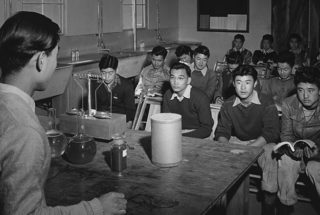
Students attend a lecture at the Manzanar War Relocation Center in California, where Japanese Americans were incarcerated during World War II from March 1942 to November 1945. This image was taken by the renowned photographer Ansel Adams, who was hired by the U.S. government to record life in the American West. (Buyenlarge/Getty Images)
As a middle schooler, early December was an agonizing time of year for civil rights activist Karen Korematsu. When the anniversary of the Pearl Harbor attack approached, she made excuses to avoid the school bus where students subjected her to racist bullying.
“Go home.”
“Go back to where you came from.”
“You don’t belong here.”
Korematsu, 70, said a teacher’s lesson about the December 7, 1941, bombing in Hawaii only added to students’ animosity toward Japanese Americans like herself. Rather than presenting “both sides of the narrative,” she said her teacher taught them that “the Japanese are very bad people” who “killed over 2,000 servicemen.”
Decades later, she said that hatred toward Asian Americans and other students of color “hasn’t changed that much,” a reality that’s been punctuated by a spike in anti-Asian hate crimes during the pandemic and the murder trial of Derek Chauvin, the former Minneapolis police officer charged in the death of George Floyd, a Black man. But a first-in-the-nation ethnic studies model curriculum for K-12 students in California, she said, gives her optimism about a more inclusive and tolerant society.
“Obviously we have not done a good job in this country of educating others about the struggles and the marginalization and the cultures that we all bring to this country,” she said. The ethnic studies curriculum, she said, will allow students to learn about the country’s diverse cultures and its long and fraught history of oppression as a strategy to foster tolerance. “We need to appreciate and celebrate our differences instead of being afraid of them.”
But Korematsu’s endorsement of the model curriculum, approved by state education officials last moth, pushed her in the middle of a contentious national debate over the way schools should teach students about the country’s history and ongoing reality of racial discrimination. That the issue became so fractious and prolonged in largely progressive, multicultural California, experts said, suggests that it could face even bigger hurdles in more conservative, less racially diverse corners of the country.
California officials have touted their 900-page creation as a model for the nation as people across America grapple with the role race and racism plays in our everyday lives. The curriculum is expected to become the backbone of a pending California bill mandating ethnic studies as a high school graduation requirement.
For Theresa Montaño, however, a professor of Chicano studies at California State University, Northridge, the curriculum is not something to be emulated and ended up being an example of what ethnic studies aims to confront.
“If anything, it’s a model of what happens when white privilege and racism begins to determine what your curriculum is going to look like,” said Montaño, one the model’s original authors who now disavows the final product.
The first-ever state-level ethnic studies curriculum won passage after four years of controversy, multiple drafts and thousands of public comments. Though the curriculum aims to build bridges between different racial and ethnic groups while elevating the voices of those who’ve long been left aside, it quickly dissolved into a battlefield for America’s raucous culture war.
Across multiple drafts, it’s faced accusations of antisemitism, promoting “woke” left-wing propaganda and sewing further racial division by teaching white children to feel guilty about past injustices. Even the state education board president, Linda Darling-Hammond, demanded a rewrite, arguing that an early draft needed to be “substantially redesigned” to ensure the curriculum is accurate and “free of bias.”
But after undergoing several substantive rewrites that sought to make it more inclusive and less radical, the original authors — a committee of ethnic studies teachers and professors including Montaño — distanced themselves from a product they argued no longer reflected their work and urged state education officials “not to give in to the pressures and influences of white supremacist, right wing, conservatives.” Rather than a reflection of traditional ethnic studies curriculum, Montaño said it became a hodgepodge of concepts that turned it into a “multicultural, all lives matter U.S. history course.”
“I would definitely say that white privilege and monied interests prevailed,” she said.
Yet Korematsu said the model curriculum is an important first step, while noting that there’s room for it to become even more inclusive down the road.
One of its sample lesson plans includes classroom instruction on America’s “unjust and unconstitutional incarceration” of Japanese Americans in the wake of Pearl Harbor. It documents that citizens with Japanese ancestry were forced into “American concentration camps” surrounded by barbed wire and guards instructed to “shoot anyone attempting to leave.”

Karen Korematsu poses with her father, the late civil rights icon Fred Korematsu, after he was awarded the Presidential Medal of Freedom from then-President Bill Clinton in 1998. (Photo by Shirley Nakao, courtesy of the Fred T. Korematsu Institute)
Along with highlighting the profound impact of interning Japanese Americans without due process, the lesson plan offers instruction on Korematsu’s father, the late civil rights icon Fred Korematsu, who became a fugitive in his effort to escape wartime incarceration. In the landmark 1944 case Korematsu v. United States, the Supreme Court ruled that the internment of more than 117,000 Japanese Americans was a military necessity.
It wasn’t until 2018, when the Supreme Court upheld former President Donald Trump’s travel ban on several Muslim-majority countries, that the court overturned its Korematsu opinion, with Chief Justice John Roberts writing for the majority that it “was gravely wrong the day it was decided.”
Though the curriculum has been accused of being divisive, toward white Americans in particular, Karen Korematsu said her father’s legacy is critical to its success. She now serves as the founder and executive director of the Fred T Korematsu Institute, which seeks to advance civil rights through education.
His fight “wasn’t just for Japanese Americans and himself, it was for all Americans,” she said. “He didn’t want something like the Japanese American incarceration to happen again to another group of people.”
The ‘low-hanging fruit’ of education reform
Though the model curriculum is new, ethnic studies has deep roots in California, with the first formal classes taught at San Francisco State University in 1968 at the tail end of the civil rights movement. Part of a growing but controversial push for “culturally relevant pedagogy” to improve the educational outcomes of historically underrepresented students, the final curriculum takes a head-on look at racism and oppression in America with a goal of “affirming the identities and contributions of marginalized groups in our society” and helping students from all backgrounds “see themselves as active agents in the interethnic bridge-building process we call American life.”
“Considering that European American-centered history and cultures are already robustly taught in the school curriculum, ethnic studies presents an opportunity for more inclusive and diverse histories and cultures to be highlighted and studied in a manner that is meaningful and can be transformative for all students,” the introduction states.
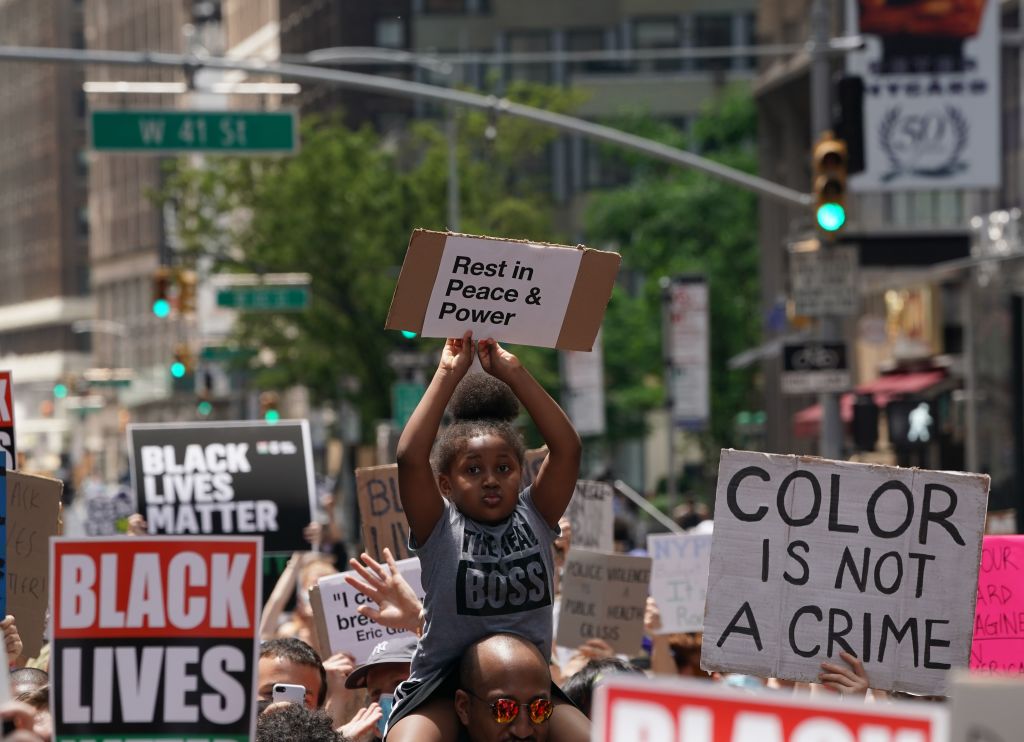
A little girl holds up a sign at a New York protest in 2020 following the death of George Floyd, who died at the hands of a Minneapolis police officer. California’s ethnic studies model curriculum includes lessons on social movements such as Black Lives Matter. (Bryan R. Smith/AFP via Getty Images)
Ethnic studies’ ability to improve educational outcomes for all students remains unclear, said the renowned education policy researcher Thomas Dee, a professor at Stanford University’s Graduate School of Education. But a report he co-authored in 2016 gives reason for optimism, particularly in closing the achievement gap between white children and students of color. The study reviewed an ethnic studies curriculum piloted at several San Francisco high schools that included students deemed at-risk of dropping out. The study found “surprisingly large effects,” including improved student attendance and grade point averages.
“I would go so far as to say I’ve never been so surprised by a result in my career,” Dee said. “When you study education policy you become accustomed to having your heart broken” when reforms struggle to move the needle. But he said the results from San Francisco were striking. “Innovative curriculum may be the low-hanging fruit of education reform.”
In a similar pursuit, the model curriculum seeks to “critique empire-building in history and its relationship to white supremacy,” challenge “racist, bigoted, discriminatory, imperialist/colonial beliefs,” connect students to past and contemporary social justice movements and build “new possibilities for a post-racist, post-systemic racism society.”
One sample lesson offers instruction on “dominant narratives” that are often “presented as apolitical, objective truth,” but often target “non-white ethnic groups who face oppression at the hands of the dominant social group.” Such strains include a belief that “America is a land of equal opportunity,” according to the curriculum, and that the “War on Drugs” beginning in the 1970s accused drug dealers and users of “causing violence, poverty and addiction” when “in actuality, this narrative was used to justify disproportionate arrests of communities of color.” Though Black and white people use illegal drugs at similar rates, “these discriminatory policies were meant to perpetuate racialized social control,” according to the curriculum.
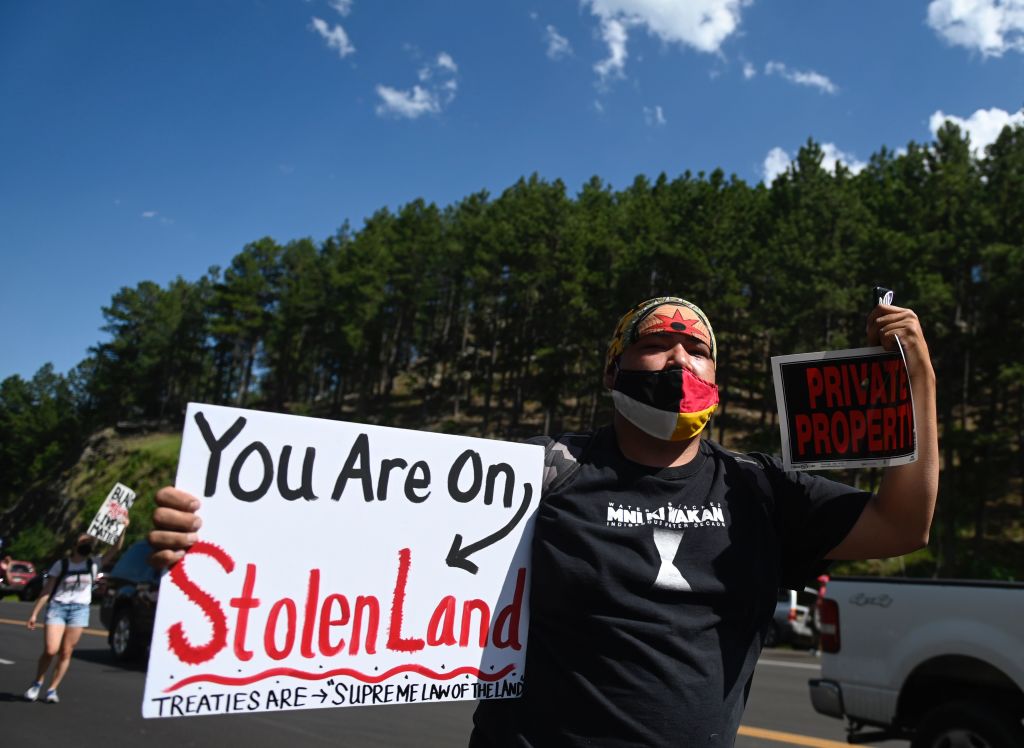
Activists and members of different tribes from the region protest in Keystone, South Dakota, on July 3, 2020, during a demonstration around the Mount Rushmore National Monument and the visit of then-President Donald Trump. (Andrew Caballero-Reynolds/Getty Images)
Though ethnic studies has long centered on four historically marginalized groups — African Americans, Latinos, Native Americans and Asians and Pacific Islanders — the final model curriculum took a more inclusive approach in the wake of backlash. For example, the end product teaches that antisemitism is “an ancient hatred that has persisted for centuries” and that anti-Jewish discrimination, “interwoven at times with white nationalism,” has increased in recent years.
Tye Gregory, executive director of the Jewish Community Relations Council in San Francisco, also sees value in teaching ethnic studies. But his group became a leading voice in opposing the state model’s early drafts, which were accused of being unfairly harsh toward Israel and for including a rap lyric about Israelis “using the press,” an antisimetic trope. Members of the Jewish Legislative Caucus criticized the early draft for omitting Jewish Americans’ contributions to Californian society and alleged that their exclusion “appeared to be intentional and reflected the political bias of the drafters.”
The rap lyric “set off alarm bells” that the Jewish community “had a problem on our hands,” Gregory said. At first, his group was OK with the curriculum’s focus on the four identified groups, he said, so long as Jewish Americans weren’t “misrepresented or denigrated.” But when the second draft expanded its focus to include instruction on the experiences of Arab Americans, their advocacy shifted to endorse a greater emphasis on Jewish Americans, a push that was ultimately successful.
Historically, Jews have been “flattened to that of a white religious minority,” Gregory said, but the final model curriculum provides a more robust conversation about Judaism and the pervasive effects of antisemitism — lessons that are particularly poignant given the current political discourse.
Man at Capitol today wearing "Camp Auschwitz" sweatshirt. Back reads "Staff" pic.twitter.com/7KRGEIvNme
— Trevor "Trev" McKee Achilles (@MrTAchilles) January 7, 2021
“When you have the Capitol insurrection with those sweatshirts that said ‘Camp Auschwitz,’” he said, “of course our community is going to feel like the stakes of how Jews are presented in the classroom is increasingly important.”
Montaño, the original curriculum author, views the situation differently. When she and other ethnic studies experts convened at the state Department of Education in Sacramento in early 2019, she said that they were given far too little time to produce a draft, a reality that left them scrambling. The State Board of Education didn’t respond to an interview request.
Ultimately, she disagrees with the final draft’s inclusive scope, noting that the document devotes just 77 pages to Chicano/Latino studies in a state where Hispanics and Latinos make up about 55 percent of the student population. While asserting the state’s final curriculum was “sanitized,” Montaño is now co-chair of the group The Liberated Ethnic Studies Model Curriculum Institute, which seeks to create a curriculum “with authenticity to the field.”
“All of a sudden everybody wants to be ethnic studies,” she said. “For 500 years, nobody wants to experience racism and marginalization, but all of a sudden everybody wanted a piece of something [they] didn’t have. It’s kind of like, you finally get a little piece of the pie and then even before you taste it, people want to take bites.”
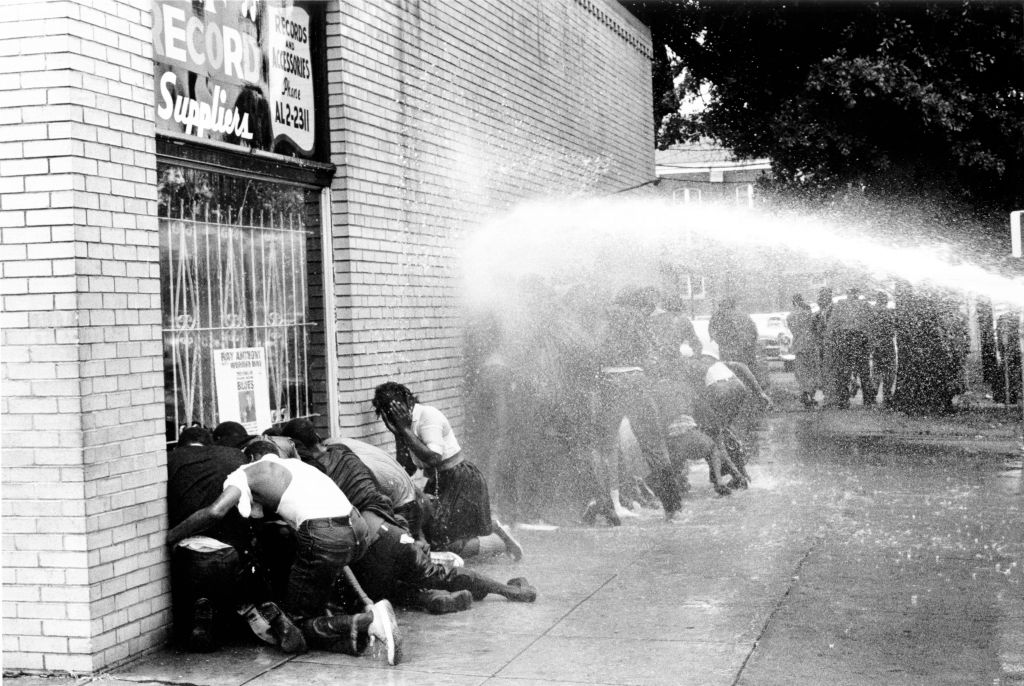
In 1963 in Birmingham, Alabama, police turned water cannons and dogs against Black children protesting against segregation. The march was organized by civil rights leaders such as Dr. Martin Luther King Jr. (Michael Ochs/Getty Images)
Viewing the ‘American creed as sinister’
To Manuel Rustin, a history teacher in Pasadena, California’s model curriculum in ethnic studies offers students the kind of instruction he wishes he got when he was a student. Most critical, he said, were the lessons and perspectives traditionally left out. He pointed to one on persistent housing segregation in cities across the U.S.
History classes have long taught about the Great Depression and how the New Deal put the country on the path to economic recovery, said Rustin, who co-chairs the state Instructional Quality Commission, which oversaw the model curriculum’s development. Absent from those lessons, however, were discussions about how a housing program created under the New Deal sought to segregate American communities.
The model curriculum offers a lesson on “redlining” and “how housing inequality has manifested in the form of institutional racism.” The Federal Housing Commission, which was created in 1934, upheld a discriminatory policy where red lines were drawn around predominantly Black neighborhoods, refusing to insure mortgages there while subsidizing the development of subdivisions where homes remained off limits to African Americans. The government-supported policy is often used to partly explain why neighborhoods — and schools — remain racially segregated today and how white families accrued wealth through real estate over the decades.
“Ethnic studies helps tell those stories of what structural or systemic racism actually is and how it plays out and then students can make connections,” Rustin said.
But discussions about the ways systemic racism continue to shape contemporary life once again pushed the state ethnic studies curriculum into controversy — this time over its use of “critical race theory,” a framework that focuses on structural racism and the way bias permeates policymaking. In the last several years, critical race theory has been sucked into the culture wars, with former President Donald Trump calling it “un-American” and signing a short-lived executive order that barred federal agencies and contractors from providing diversity training that included critical race theory.
In a recent column, the Wall Street Journal’s Editorial Board called the model curriculum an effort to “enlist students in progressive politics,” arguing that its use of critical race theory teaches students “to view the American creed as sinister.”
Among critics is Lori Meyers, a first-grade teacher at a private school in the Bay Area who created the group Educators for Excellence in Ethnic Studies to combat the model curriculum’s reliance on critical race theory. Though she believes that students should be taught “the true story of racism in our country, warts and all,” she said that critical race theory is “divisive and discriminatory,” and should therefore not be used as a primary strategy to teach children about race.
She promoted several state bills, including one in Rhode Island, that would prohibit schools from teaching it to students. To make her argument, she points to comments made by the late Derrick Bell, a Harvard University law professor credited as one of critical race theory’s originators, who wrote that “progress in American race relations is largely a mirage, obscuring the fact that whites continue, consciously or unconsciously, to do all in their power to ensure their dominion and maintain their control.”
“What we don’t agree with is having students being grouped by race now, and we’re talking about now in classrooms, and being made to feel guilt or responsibility for something that happened a long time ago,” she said. “That’s critical race theory. Critical race theory looks at things that are happening now through an exclusive lens of race.”
But Rustin said that the theory’s opponents have “politicized and distorted” its intentions, adding that it isn’t about “blaming individuals” for their role in structural racism and making people feel guilty, but is simply a framework to explain how racism in the past, such as the “separate but equal” segregation doctrine upheld in 1896 by Plessy v. Ferguson,have perpetuated persistent racial disparities in issues like health care, economics and criminal justice.
If educators don’t push back, he said, then “it’ll be nearly impossible for any school and teacher to be allowed to actually teach about America’s racial past and racial present because no matter what you say it’s going to be framed as being bad or being liberal or being indoctrination,” he said. “Educators need to be clear about why we need anti-racism.”
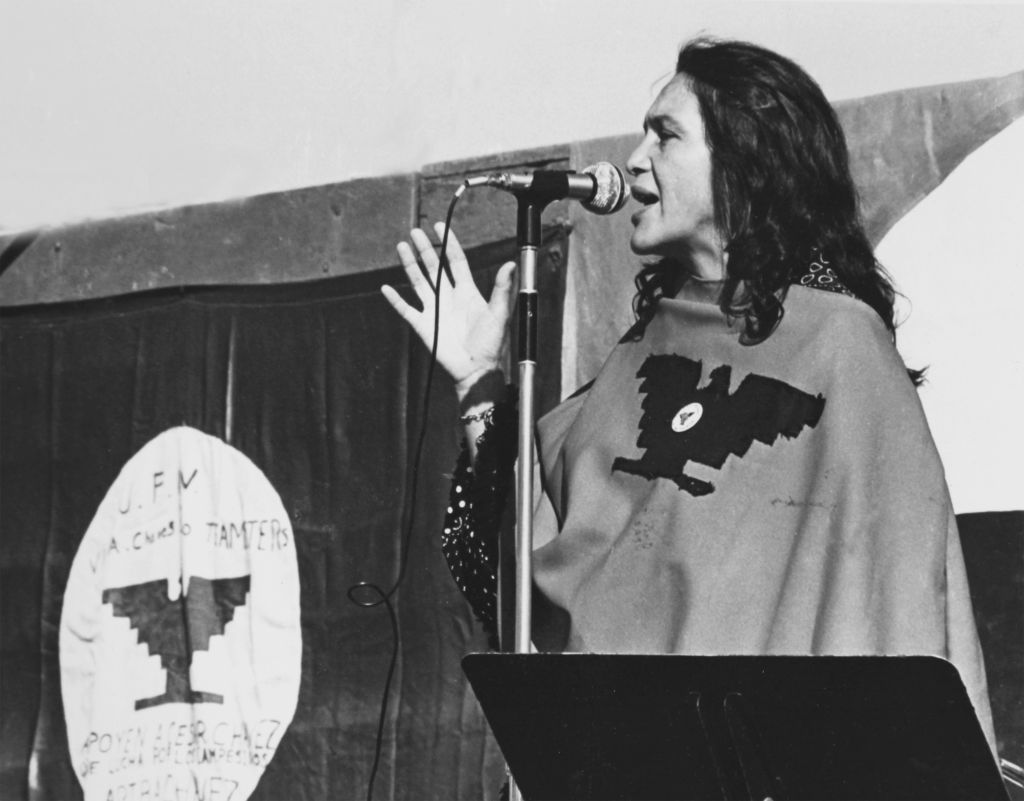
American labor activist and co-founder of the United Farm Workers of America Dolores Huerta speaks on stage during a UFW rally in the mid-1970s in California. Huerta endorsed the state’s new model curriculum in ethnic studies. (Cathy Murphy/Getty Images)
Turning down the heat, turning up the light
In her years of teaching ethnic studies, Julia Jordan-Zachery, a professor of Africana Studies at the University of North Carolina at Charlotte and president of the Association for Ethnic Studies, has found tremendous value in the discipline for all students, including those who are white. She said that all students, including those with European ancestry, are given “an opportunity to see themselves represented” and to “grapple with identity” and become critical consumers of information.
Its detractors, she said, ignore the fact that “knowledge is vested in power,” that those with power shape prevailing narratives. But how any historical event is interpreted is open for debate.
“History is a tale we tell around a series of events,” she said. “What ethnic studies seeks to do is say different groups have experienced that same event possibly in a different way.”
To make the case, she pointed to the classic series Little House on the Prairie, based on Laura Ingalls Wilder’s childhood as a white settler on the American Great Plains, which has been criticized for its portrayals of Native Americans. Instead of erasing the true experiences of indigenous people, she said, what if the beloved children’s books included them, allowing more young readers to see themselves in the story?
Without receiving a complete accounting of American history, many of her college students are shocked about the subjects that were left out of their high school experiences. That’s the benefit she sees in California’s model curriculum and how it’s elevated ethnic studies’ awareness. While many students “feel cheated” by their K-12 educations, the model curriculum provides “an opportunity to address that before they get to me at college,” she said.
In order for the model curriculum to be successful, she said it all comes down to implementation. Now, as the California state Legislature considers an ethnic studies graduation requirement, the culture war could shift to the local level as individual school districts across the state respond. Rustin, the Pasadena history teacher, noted that each of the curriculum’s versions are publicly available and that he plans to use “bits and pieces of all the different drafts” in his classroom.
Dee, the Stanford researcher, agreed about the importance of how the curriculum is carried out. While his study showed serious promise in San Francisco, he said the course was implemented with careful teacher training, highly motivated educators and a thoughtful deliberation about which lessons should be taught.
But to create national momentum around ethnic studies in K-12 schools, he said it’s important that the discipline becomes more than “just another pawn in the broader culture wars debate.”
“I would like to see us turn down the heat and turn up the light,” he said. “I would love to see local school districts consider adapting and adopting a curriculum like this for their own communities, but critically coupling that with serious assessment efforts to understand whether it’s working.”
This article was published in partnership with The 74. Sign up for The 74’s newsletter here.